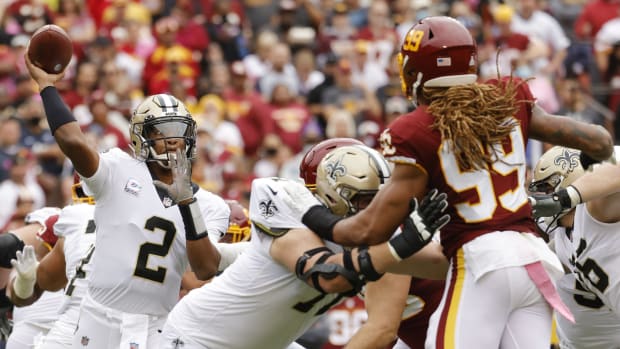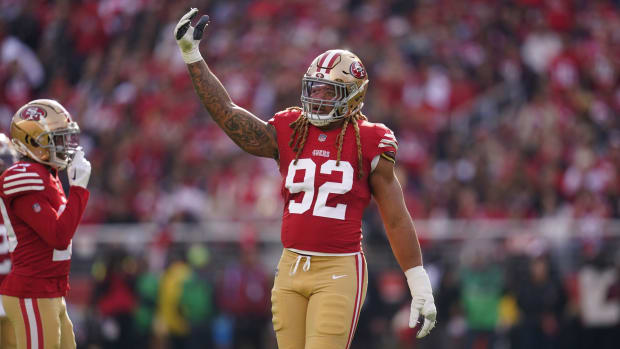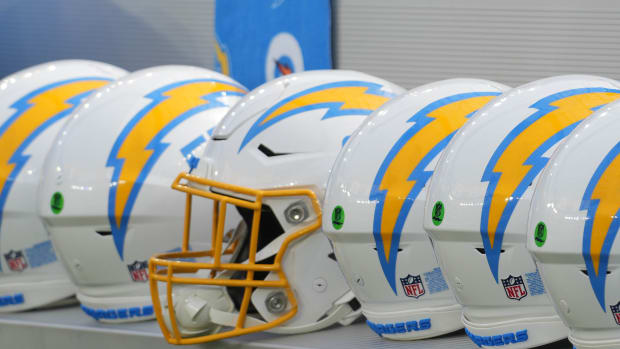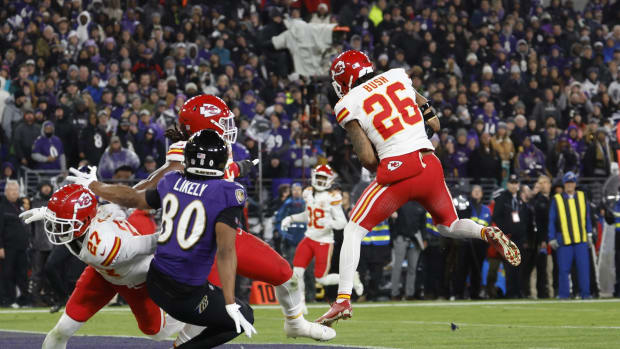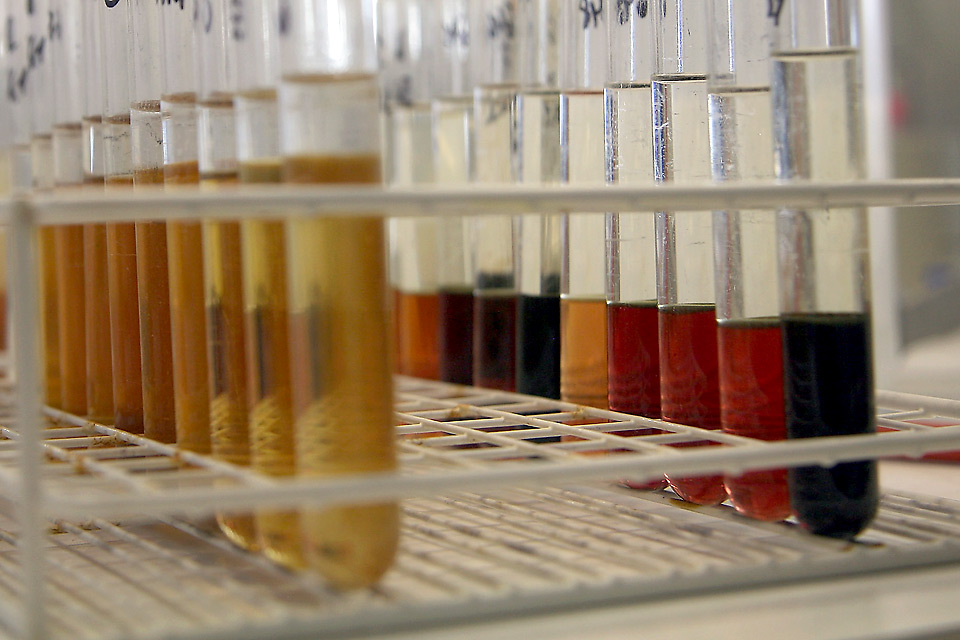
A First Step Toward HGH Testing—in the Wrong Direction
After two years of relative stalemate, the NFL and the Players’ Association have agreed in principle to collaborate on a study that would remove one of the major hurdles to HGH testing. On Monday an e-mail from the union advised players to prepare to give blood samples during training camp as part of an NFL “population study.”
The point of a population study is to characterize normal growth hormone levels in a particular group—in this case, NFL players—so that biostatisticians can set a cutoff or “decision limit,” essentially, a goal line on one side of which a test is positive, and on the other negative.
The World Anti-Doping Agency has already conducted such studies of athletes and used them to set decision limits in Olympic sports. (The WADA guidelines are also used by Major League Baseball.) But during the NFL’s two-year-long impasse over HGH testing, which was agreed to in principle in the 2011 CBA, the union was adamant that NFL players are a unique population, potentially with special growth hormone profiles, and thus deserve a separate study to determine their decision limits. Says Domonique Foxworth, president of the NFLPA, “Just assuming that we can follow guidelines about someone’s body that were set up with a population study on non-football players, I think, is somewhat problematic.”
Now the players will get their population study, led by a doctor and two biostatisticians—one of whom, Donald Berry, has been very critical of the methods used to arrive at drug testing decisions limits—agreed upon by the league and union. While there are still plenty of issues to be worked out, it’s certainly a step toward HGH testing. But as for ridding the league of HGH use, even when the other issues are resolved—the union, for one, wants Roger Goodell out of the picture with respect to any discipline that would result from a positive test—we shouldn’t hold our breath.
In terms of their natural HGH profiles, NFL players almost certainly are not a unique population. They’re humans, just like everyone else. The test that the league and the union are considering, known as the “isoform test,” looks for a ratio of different types (or isoforms) of growth hormone in the body. Two of the primary forms differ by their weight; one weighs 20 kilodaltons and the other 22 kilodaltons. But synthetic HGH comes only in the 22-kilodalton variety. So when an athlete injects synthetic HGH, the drug upsets the normal ratio of isoforms in the body, and that is what the test picks up. By WADA standards, if an athlete’s ratio is more than about three times normal, he’ll be classified as having used HGH.
The data thus far show that a person’s ratio is relatively stable over time, and that isoform ratios do not differ with age, body weight or height. NFL players’ ratios, that is, should not diverge from those of high jumpers or shot putters or rugby forwards or centerfielders or armchair QBs. Not naturally, anyway.
But here’s how NFL players might differ: It’s long been suspected (if not taken for granted) that HGH use is prevalent in the league. While it might not reach the 60% to 70% level that former quarterback Boomer Esiason estimated last year, NFL strength coaches who spoke with me on condition of anonymity said they believed a significant number of players use HGH, given that it can be used with impunity, that many of the potential short-term side effects (like joint swelling) appear reversible when a player stops using, and that the lone, randomized study that looked at HGH specifically for speed enhancement found a real benefit in using it. Essentially, if NFL players aren’t using HGH, it’s more an ethical or health decision than anything else.
The decision limits might be set so high that nobody will ever fail a test.
If Esiason is anywhere in the ballpark about the prevalence of HGH use, then an NFL-specific population study will give results that are massively skewed by current HGH users. Adolpho Birch, the NFL’s senior vice president of law and labor policy, told me last month that the league does not believe an NFL study makes sense but that “the goal the commissioner set is to get testing. Without being too specific, we’re willing to do what needs to be done to get that.” But it absolutely doesn’t make sense under any circumstances if the study is just going to a give a profile of a community rife with HGH users. In fact, if the results of the test will only be used to establish the limits—a letter the union sent to its members said no other use would be made of the data, meaning no retroactive discipline for a high HGH level—a cynic might suggest that NFL players should make sure to use HGH before their blood is drawn for the population study. Then the decision limits might be set so high that nobody will ever fail a test. It would be like using the NBA as a reference population for a height study.
A TEST OF QUESTIONABLE VALUE
Catching an athlete using HGH is difficult enough as it is, without skewed decision limits. Drug testing in sports works along a particular ideal of a justice system: Conservative testing thresholds ensure that many guilty parties will skate; in return, the chance of accusing an innocent person is minimized. That is one reason why, from more than 10,000 HGH tests around the world since 2004, only 12 have come back positive. In an early study on the isoform test, even the subjects who were intentionally doped for research purposes did not exceed the current isoform test cutoff of 1.8 for a positive. The other reason why there are so few HGH positives is that the detection window using the isoform test is between 10 and 20 hours.
The NFL’s current drug testing policy restricts random in-season testing to two days each week, and only 10 players per team are tested. (One of those days is typically Monday so testers can look for stimulants with short detection windows that were taken for games.) Let’s assume it’s not hard for one of the other players to find out when a teammate was tested. With a test that has a detection window of less than 20 hours, and players who can conceivably figure out days on which they won’t be tested ... you get the idea. (This isn’t even to mention the fact that the isoform test has no chance of picking up other forms of growth-hormone doping that don’t involve injecting a synthetic version, like the use of secretagogues, agents that cause the pituitary to release more growth hormone.) Even if the isoform test were put in place tomorrow, it’s hard to imagine much of an impact beyond getting Congress off the NFLPA’s back.
HGH Has Its Uses
Blame Canadian sprinter Ben Johnson for some of the restrictions on HGH in the U.S. After his failed steroid test at the 1988 Olympics, the U.S. Congress cracked down on performance-enhancing drugs in sports. But the laws regulating HGH became so ambiguous that American doctors have a hard time interpreting them, and some prescribe HGH off-label (for uses other than those approved by the FDA, which include AIDS-related wasting and severe growth hormone deficiency) where they think it will help their patients, though it is illegal to do so. Florida orthopedic surgeon Allan Dunn has been something of a pioneer in that regard and claims to have treated more than 1,000 patients, including athletes such as former NFL running back Abdul-Karim al-Jabbar. Dunn says he believes HGH injected into the knee may help the human body grow cartilage, and that he saw this occur in tests on rabbits. He and others, perhaps most prominently Canadian doctor Anthony Galea, suggest that restricting HGH use curtails work with a drug that might actually help athletes recover from surgery. (Off-label use of HGH is legal in Canada.) Todd Schlifstein, a New York-based sports rehabilitation expert who testified before Congress in 2008 about HGH abuse, says: “Like any medicine, side effects can occur. Appropriate medical monitoring is needed. Also, there are many potential benefits from HGH use, which are now difficult to prescribe in the U.S. and study in the U.S. because of legislation.” —D.E.
If that is the goal, then using the isoform test based on an NFL population-study is a great idea. In January, congressmen Darrell Issa and Elijah Cummings of the House Oversight and Government Reform Committee wrote a letter chiding the NFLPA for stalling rather than following the example of the MLBPA, and they threatened to take a hands-on approach. But it’s pretty clear that the government has little regard for the nosetackle-sized devils in the details.
Baseball has made tremendous strides in anti-doping in recent years, and of the professional leagues its procedures are closest to the kind of testing to which Olympians are subject. In collective bargaining in 2011, MLB and the union agreed to begin HGH testing—MLBPA executive director Michael Weiner says the positive test of minor leaguer Mike Jacobs was a factor—essentially pending agreement on the details of implementation before in-season testing would start. Sound familiar? And yet, as far as baseball has come, it doesn’t exactly have a halcyon consensus on HGH testing.
In 2013, baseball amended its Joint Drug Testing Agreement to include in-season blood testing for HGH, but with a special provision carved out only for the isoform test. Should a major leaguer test positive for HGH, he has the right to challenge in arbitration not just his specific test, but the entire underlying science of the isoform test. This provision does not exist for other drugs, like nandrolone, for which the testing science is agreed upon. “The reason we went forward,” Weiner says, “was that on the one hand we believed that there was some scientific validity to what we saw [in the isoform test]. On the other hand we weren’t really sure.” In other words, MLB and the MLBPA built into the agreement a degree of uncertainty about the test; it just hasn’t been challenged because no major leaguer has come up positive yet. And thanks to a recent Court of Arbitration for Sport ruling that overturned the HGH positive of an Estonian skier because of questions about WADA’s decision limits, if a baseball player did test positive, “I think it would be very difficult to uphold,” Weiner says.
So while congressmen Issa and Cummings are chiding the NFLPA and using MLB as a model, baseball’s HGH agreement would be hard-pressed to actually produce a sanction, at least until the decision limits are bolstered (a process WADA is currently undertaking). And Birch says the NFL has offered the current MLB program “essentially word for word” to the NFLPA.
THE BETTER WAY FORWARD
Rather than haggling over the isoform test, if the NFL and the union want to get tougher on doping in general, they should strengthen their current testing protocol by opening the entire week to the possibility of random testing. Just as one’s HGH isoform ratio returns to normal quickly after an injection, there are forms of testosterone that can cause a spike in the testosterone-to-epitestosterone ratio (the first layer of testing looks for this “T/E ratio”) that then returns to normal in hours. So any system that gives an athlete a way to deduce days on which he will not be tested has a massive hole.
The NFL could also make more frequent use of a test called IRMS, which can detect synthetic testosterone use even in the absence of an elevated T/E ratio. (IRMS testing is typically only done for confirmation when an elevated T/E ratio is detected.) From conversations with athletes, doctors, and steroid dealers over the last few years, I’m convinced that athletes rarely use HGH alone, and that anywhere HGH is used, testosterone is used more. Christiane Ayotte, head of the WADA-accredited lab in Montreal, says that her lab handled two cases of baseball players in which T/E ratios were normal but IRMS testing found synthetic testosterone. The NFL has for years used some random IRMS testing on samples that don’t have elevated T/E ratios.
The NFL and NFLPA ... might do better looking toward the next technology rather than conducting a population study that will be redundant at best and futile at worst.
If the NFL and the NFLPA are intent on slogging through an HGH testing agreement between collective bargaining periods, the parties might do better looking toward the next technology rather than conducting a population study that will be redundant at best and futile at worst.
The London Olympics last summer marked the first use of a new HGH test called the biomarker test. This looks for telltale increases in particular blood markers that show up after HGH injection. The biomarker test does not pick up doping within the previous two days, but the detection window extends back beyond that for at least a week, so it has the potential to be much more effective than the isoform test. In addition, the biomarker test has been in development since 1996, and the research process has produced mounds of peer-reviewed scientific literature, so it is not subject to the kind of legal challenges that the isoform test is.
Believe it or not, a big part of the delay in implementation of the biomarker test—it is still in relatively limited use—has been the lack of a steady supplier for the testing kits. That, of course, can be remedied, particularly if a wealthy league wanted to make it a priority. (Says the NFL’s Birch, “It is incumbent first to get agreement on the test that is fully operational.”)
































